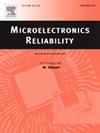Solving bump bonding issues with 2.0 mil copper wire: A study on FSM integration and workability improvements
IF 1.6
4区 工程技术
Q3 ENGINEERING, ELECTRICAL & ELECTRONIC
引用次数: 0
Abstract
Bump bonding with 2.0 mil copper (Cu) wire presents significant workability challenges when using aluminum (Al) pads alone, regardless of thickness. To address these issues, this study evaluates the integration of Front-Side Metal (FSM) layers (Ti/NiV/Ag) and their impact on process performance. Two Al pad thicknesses (0.8 μm and 3.0 μm) were tested in combination with two FSM configurations (1 k/3 k/1.5 k Å and 1 k/3 k/6 k Å) to assess process windows, defect rates, and reliability metrics. The results confirm that FSM layers are essential for enabling successful bump bonding with 2.0 mil Cu wire. The 0.8 μm Al pad with 1 k/3 k/6 k FSM demonstrated superior workability, achieving a ± 15 % process window, compared to the ≤ ±5–10 % range observed in other configurations. Defect rates were also significantly lower (<3 %) compared to 13–36 % in alternative configurations. A key factor influencing workability was the non-stick on pad (NSOP) rate, which was significantly reduced in the 0.8 μm Al pad with 1 k/3 k/6 k FSM configuration. The thicker Ag layer in this combination improved bond formation by enhancing energy transfer and stress distribution, minimizing bond pad contamination and adhesion failures. Other configurations, particularly those with thinner Ag layers or thicker Al pads, exhibited higher NSOP rates, leading to narrower process windows and increased defect rates. Reliability assessments, including Moisture Sensitivity Level (MSL) tests and Scanning Acoustic Tomography (SAT) analysis, confirmed that all configurations exhibited no delamination or structural failures. Final test results showed yield rates of 99–100 % for the 0.8 μm Al pad with 1 k/3 k/6 k FSM, while other configurations had slightly lower yields (97–100 %). Additionally, all configurations passed cratering tests, further validating the robustness of the FSM-integrated process. This study demonstrates that FSM layers are critical in overcoming workability limitations in 2.0 mil Cu wire bump bonding. The findings emphasize the importance of optimizing both Al pad thickness and FSM layer composition to enhance manufacturability and reliability in advanced copper wire bonding applications.
求助全文
约1分钟内获得全文
求助全文
来源期刊

Microelectronics Reliability
工程技术-工程:电子与电气
CiteScore
3.30
自引率
12.50%
发文量
342
审稿时长
68 days
期刊介绍:
Microelectronics Reliability, is dedicated to disseminating the latest research results and related information on the reliability of microelectronic devices, circuits and systems, from materials, process and manufacturing, to design, testing and operation. The coverage of the journal includes the following topics: measurement, understanding and analysis; evaluation and prediction; modelling and simulation; methodologies and mitigation. Papers which combine reliability with other important areas of microelectronics engineering, such as design, fabrication, integration, testing, and field operation will also be welcome, and practical papers reporting case studies in the field and specific application domains are particularly encouraged.
Most accepted papers will be published as Research Papers, describing significant advances and completed work. Papers reviewing important developing topics of general interest may be accepted for publication as Review Papers. Urgent communications of a more preliminary nature and short reports on completed practical work of current interest may be considered for publication as Research Notes. All contributions are subject to peer review by leading experts in the field.
 求助内容:
求助内容: 应助结果提醒方式:
应助结果提醒方式:


